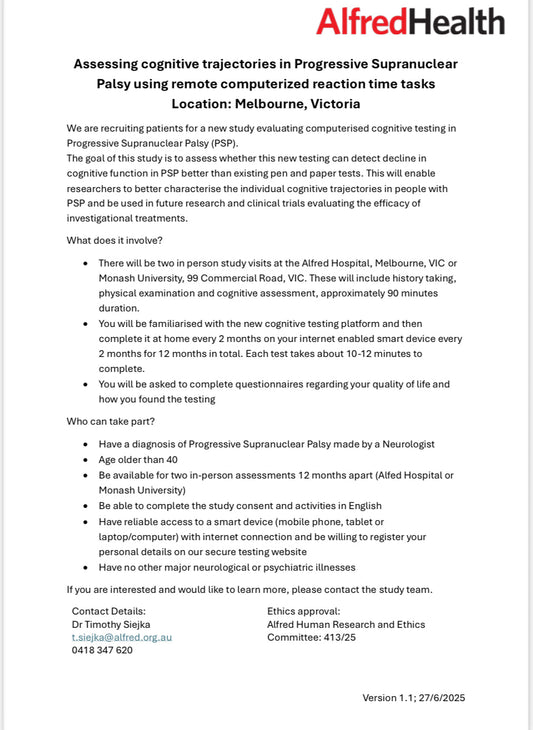It has been said there are four stages, but because there is so little research they are a guideline only.
Many people experience some stage four symptoms at stage one or overlap stages. Some never experience certain symptoms and then others can experience ones not listed. The impact it has on each individual varies dramatically.
Progressive Supranuclear Palsy (PSP) is a rare neurodegenerative disorder that affects movement, balance, vision, speech, and cognitive function. The disease progresses slowly over time, and its symptoms typically become more severe as the disease advances. While not everyone with PSP experiences the same symptoms or progression, there are generally four recognized stages of PSP:
-
Early stage: In the early stage of PSP, individuals may experience symptoms such as difficulty with balance and coordination, changes in gait, and problems with eye movement. These symptoms may be subtle and easily dismissed as normal aging or a different condition.
-
Mid-stage: In the mid-stage of PSP, symptoms become more pronounced and can include falls, speech and swallowing difficulties, and cognitive impairment such as problems with memory and executive function. Depression and apathy are also common.
-
Advanced stage: In the advanced stage of PSP, individuals may become wheelchair-bound and require assistance with daily activities such as eating, dressing, and bathing. Symptoms such as rigidity, spasticity, and involuntary movements become more severe.
-
End-of-life stage: In the end-of-life stage of PSP, individuals may be bedridden and require around-the-clock care. They may have difficulty swallowing, become more susceptible to infections, and experience other complications related to the progression of the disease.
It's important to note that not everyone with PSP will experience all of these stages, and the progression of the disease can vary widely from person to person. Additionally, some individuals may experience rapid progression, while others may experience a slower course of the disease.
Here is the four stages below in more detail;
Early stage:
May present via the fracture clinic, falls services, eye specialist or speech and language therapist. The early stage typically spans years 0-1.
> Ambulant.
> Occasional falls.
> Unsteadiness and poor balance.
> Possible visual problems affecting ability to read.
> Voice changes, for example reduced volume.
> Mood changes.
> Reduced socializing.
> Changes in mood and behavior, including apathy and anxiety.
Mid stage:
Many people reach this stage before diagnosis. Consider discussing advance care planning and advance decisions to refuse treatment. Consider referral to palliative care services. The mid stage typically spans years 2-3.
> Ambulant with aids.
> High risk of falls and injury.
> Visual problems affecting self-care abilities, for example eating and walking as unable to move eyes to see.
> Speech increasingly unintelligible.
> Inability to initiate conversation.
> Impulsivity (risky or impulsive behavior).
> Apathy.
> Dysphagia.
> High level of supervision required.
> Increasingly socially withdrawn.
Advanced stage:
Patients should be on GP palliative care register and have access to specialist palliative care.
The advanced stage typically spans years 3-6.
> Mobility significantly compromised, probably chair bound requiring a wheelchair for mobility.
> Significant visual problems.
> Significant muscle stiffness.
> Significant communication problems, but probably still able to understand.
> High risk of aspiration and pneumonia as a result of dysphagia.
> Pain.
> Increasing periods of sleepiness.
> Incontinence.
> Severely withdrawn socially.
> Dependent for most or all aspects of care.
End of life stage:
This stage is difficult to detect, but may be indicated by reduced levels of consciousness, inability to eat or drink, acute infection, a fall or major fracture, and rapid and significant weight loss. The end of life stage typically spans 6-8 weeks.
> Severe impairments and disabilities.
> Rapid and marked deterioration in condition.
> Decisions with regard to treatment interventions may be required, considering an individual’s previously expressed wishes (advance decisions to refuse treatment).
Discover the Benefits of Vielight Red Light Therapy for Atypical Parkinsonism


 Donate
Donate




131 comments
My dear stepmother bravely battled Parkinson’s for years and then PSP for 11 more years. Advice: it truly takes a team to provide extensive care to those battling this illness; don’t battle this alone. Caregivers, this means you too! The physical, emotional, and mental toll on a caregiver/loved one is extreme. Build your support team now!
My mom was diagnosed with PSP in 2021. She has severely deteriorated since. She is now in a wheelchair and has trouble speaking. She falls backwards all the time and my family placed her in assisted living knowing she needs care around the clock. I live on the opposite side of the country and it’s really sad the family is in such denial. My mom deserves better. She’s only 68.
Iam suffering from psp disease for four years Particularly my eyes not able to recollect the things It take me to one and hal
My dad was diagnosed with PSP in February 2023 but for years we new something just wasnt right. He became angry, then dizzy which we all thought was vertigo then he found it difficult to walk and look after himself.
His brother passed away wth PSP some years ago and for years the drs said it doesnt run in the family.
Dad is now in permanent care and can no longer feed himself.
PSP is a horrible disease. We will look after you dad until the day it sets you free. xxxx
My husband was diagnosised with Parkinson’s 7 years ago and Psp 4 years ago he can no longer walk or feed himself he must wear a diaper I take care of everything.He wakes me up all night long to turn him or change him.I don’t know how much longer I can do this.